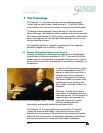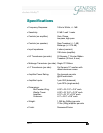
Ver 2.0
23
2323
23
~ÄëçäìíÉ=ÑáÇÉäáíó
drivers. Each works at very low-stress. This dramatically lowers the
distortions in the high frequencies at all reasonable listening volumes.
4.3 75-inch midrange ribbon
We sometimes say that the midrange is a window into the mind of a
composer or a singer. And indeed, the midrange is where the “magic”
is in a well-recorded musical event. This is why the G1.1 loudspeaker
system uses a single 75-inch ribbon per channel as a dipolar line-
source to reproduce these critical frequencies.
The midrange ribbon used in the G1.1 is manufactured to Genesis’
specifications. The ribbon itself is made of a very thin layer of
aluminum laminated to a substrate of mylar that is 0.001inch thick.
The ribbon is then suspended in the magnetic field created by over 36
feet of barium-ferrite magnets.
The result is a perfect line-source ribbon generating a continuous and
perfectly coupled wave front. The benefit of this to the listener is a
wide and even horizontal dispersion yielding a large and highly stable
sweet spot.
As a line-source dipole, the midrange ribbon has a vertical dispersion
pattern identical to that of the line array of tweeters. This insulates the
listener from the room’s negative effects, and enhances the sense of
spaciousness and depth.
4.4 The Servo-bass Advantage
Very few loudspeakers use servo drive, either because most
designers think that it is too difficult to design, too expensive or
because of the extraordinary demands a servo system makes on the
amplifier and the transducer. However, Arnie Nudell who originally
started Genesis, first introduced the servo system in the legendary
Infinity Servo Statik One in 1968. The system has evolved, and been
improved for the last 40 years, and the one used in the Genesis 1.1 is
the latest state of the art.
The concept of our servo-bass system is an easy one to understand.
It employs an accelerometer as a sensor to constantly monitor the
movement of the woofer cone and instantaneously compare it to the
input signal. This comparison circuit identifies any deviation from the
input signal and applies a corrective signal to compensate; resulting in
the virtual elimination of the inherent distortion of the woofer.
As an example, when you have a high-impact, low-bass signal that
starts and stops suddenly (for example a tympani), the inertia of the


















